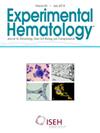Understanding Human Oncogene Function and Cooperativity in Myeloid Malignancy Using iPSCs
IF 2.1
4区 医学
Q2 HEMATOLOGY
引用次数: 0
Abstract
Myeloid malignancies are a spectrum of clonal disorders driven by genetic alterations that cooperatively confer aberrant self-renewal and differentiation of hematopoietic stem and progenitor cells (HSPCs). Induced pluripotent stem cells (iPSCs) can be differentiated into HSPCs and have been widely explored for modeling hematologic disorders and cell therapies. More recently, iPSC models have been applied to study the origins and pathophysiology of myeloid malignancies, motivated by the appreciation for the differences in human oncogene function and the need for genetically defined models that recapitulate leukemia development. In this review, we will provide a broad overview of the rationale, the challenges, practical aspects, history, and recent advances of iPSC models for modeling myeloid neoplasms. We will focus on the insights into the previously unknown aspects of human oncogene function and cooperativity gained through the use of these models. It is now safe to say that iPSC models are a mainstay of leukemia modeling “toolbox” alongside primary human cells from normal and patient sources.
利用iPSCs了解人类癌基因在髓系恶性肿瘤中的功能和协同性。
髓系恶性肿瘤是由遗传改变驱动的一系列克隆性疾病,遗传改变共同赋予造血干细胞和祖细胞(HSPCs)异常的自我更新和分化。诱导多能干细胞(iPSCs)可以分化为HSPCs,并已被广泛探索用于血液系统疾病的建模和细胞治疗。最近,iPSCs模型已被应用于研究髓系恶性肿瘤的起源和病理生理,这是由于对人类癌基因功能差异的认识以及对概括白血病发展的遗传定义模型的需要。在这篇综述中,我们将对iPSC模型用于髓系肿瘤建模的原理、挑战、实践方面、历史和最新进展进行综述。我们将重点关注通过使用这些模型获得的人类致癌基因功能和协同性的先前未知方面的见解。现在可以肯定地说,iPSC模型是白血病模型“工具箱”的支柱,与来自正常和患者来源的原代人类细胞一样。
本文章由计算机程序翻译,如有差异,请以英文原文为准。
求助全文
约1分钟内获得全文
求助全文
来源期刊

Experimental hematology
医学-血液学
CiteScore
5.30
自引率
0.00%
发文量
84
审稿时长
58 days
期刊介绍:
Experimental Hematology publishes new findings, methodologies, reviews and perspectives in all areas of hematology and immune cell formation on a monthly basis that may include Special Issues on particular topics of current interest. The overall goal is to report new insights into how normal blood cells are produced, how their production is normally regulated, mechanisms that contribute to hematological diseases and new approaches to their treatment. Specific topics may include relevant developmental and aging processes, stem cell biology, analyses of intrinsic and extrinsic regulatory mechanisms, in vitro behavior of primary cells, clonal tracking, molecular and omics analyses, metabolism, epigenetics, bioengineering approaches, studies in model organisms, novel clinical observations, transplantation biology and new therapeutic avenues.
 求助内容:
求助内容: 应助结果提醒方式:
应助结果提醒方式:


